Germany
Reichenau
The Monastic Island of Reichenau developed around an influential Benedictine Abbey from the Early Middle Ages.
The island holds a group of medieval churches that retain elements of Carolingian, Ottonian, and Salian architecture. The Abbey housed a school, and a scriptorium and an artists' workshop. It reached its apex in the 10th and 11th centuries; with its monumental wall paintings and its production of lavishly illuminated manuscripts, it made a significant contribution to European art of that period.
Community Perspective: You actually have to go and look at three churches (St Mary and Marcus, St Peter and St Paul, and St George), that’s where the 10th-century murals are. St. George (the best) has very limited opening hours and needs a guided visit, so plan your visit accordingly.
Site Info
Official Information
- Full Name
- Monastic Island of Reichenau (ID: 974)
- Country
- Germany
- Status
-
Inscribed 2000
Site history
History of Reichenau
- 2000: Inscribed
- Inscribed
- Type
- Cultural
- Criteria
- iii
- iv
- vi
Links
- UNESCO
- whc.unesco.org
- Official
-
- reichenau-tourismus.de — Reichenau Island
- Related
-
- museumreichenau.de — Museum Reichenau (in German)
- newadvent.org — Link
All Links
UNESCO.org
- whc.unesco.org — whc.unesco.org/
Official Website
- reichenau-tourismus.de — Reichenau Island
Related Resources
- museumreichenau.de — Museum Reichenau (in German)
- newadvent.org — Link
Community Information
- Community Category
- Religious structure: Christian
Travel Information
Recent Connections
-
Perfect Inscriptions
2000 -
Ramsar Wetlands
Bodensee: Wollmatinger Ried - Giehrenmo… -
Stuttgart Hotspot
Connections of Reichenau
- Geography
-
-
Notable lakes
Lake Constance -
Rhine
-
- History
-
-
Holy Roman Empire
The monastic island of Reichenau was in the 8th-11th centuries one of the cultural and artistic centres of the German Holy Roman Empire, over which it exercised considerable influence. (AB ev) -
Carolingian Empire
-
- Architecture
-
-
Rococo
church of St Peter & Paul at Niederzell "was decorated in rococo style in the 18th century" (AB ev) -
Pre-Romanesque
St. George -
Romanesque
church of St Peter and St Paul at Niederzell (AB ev) -
Timber framing
Hohes Haus
-
- World Heritage Process
-
-
Perfect Inscriptions
2000
-
- Religion and Belief
-
-
Hiberno-Scottish Mission
Pirmin founded Reichenau abbeySee en.wikipedia.org
-
Religious Relics
Head of St. George, the relics of St Mark the Evangelist, and many others -
Benedictines
Abbey of Reichenau
-
- Human Activity
- WHS on Other Lists
-
-
Memory of the World
Illuminated manuscripts from the Ottonian period produced in the monastery of Reichenau (Reichenau) -
Ramsar Wetlands
Bodensee: Wollmatinger Ried - Giehrenmoos & Mindelsee
-
- Timeline
-
-
Built in the 8th century
Founded in 724
-
- WHS Hotspots
- Visiting conditions
News
No news.
Recent Visitors
Visitors of Reichenau
- Adrian Turtschi
- Afshin Iranpour
- Alexander Barabanov
- Alexander Lehmann
- Alexander Parsons
- alicemears
- A. Mehmet Haksever
- Ana Lozano
- Antonio J.
- Argo
- AS
- Aspasia
- Astraftis
- a.thum
- Atila Ege
- BaziFettehenne
- Bin
- Bodil Ankerly
- Bropyk
- Can SARICA
- Caspar
- Cezar Grozavu
- chenqtao
- Christer Sundberg
- Christian Wagner
- Christine
- christof
- Christoph
- Christravelblog
- Claire Bradshaw
- Clyde
- Colossus
- Cristina Erba
- Csaba Nováczky
- ctravel
- CugelVance
- Daniela Hohmann
- Daniel Chazad
- Dan Pettigrew
- David Berlanda
- Deffra
- Dimitar Krastev
- Dimitrios Polychronopoulos
- Dirk-pieter
- Dolemite92
- Dorejd
- Echwel
- Els Slots
- erdsaumnaht
- Errol Neo
- Eva Kisgyorgy
- Fam39
- Fan Yibo
- Farinelli
- Federico P.
- Feldhase
- FK
- Frederik Dawson
- FS
- Gary Arndt
- Geert Luiken
- George Gdanski
- GeorgeIng61
- Gernot
- HaraldOest
- Harald T.
- Harry Mitsidis
- Hasco
- heywhatever2
- Hubert
- Iain Jackson
- Ian Cade
- ih0000
- Ivan Rucek
- Jakob F.
- Jana and Matt
- janem
- Janina Lehmann
- Jan-Willem
- Jan Zimmermann
- Jarek Pokrzywnicki
- Jasam
- Javier Coro
- Jawnbeary
- Jay T
- Jean Lecaillon
- Jeanne OGrady
- Jeffrey Chai
- Jens
- Jezza
- Joel on the Road
- Jonas Hagung
- Jonas Kremer
- Jonas Martinsson
- KarenBMoore
- Karito Vies
- Kbecq
- Kerékgyártó
- Kevin247
- Klaus Freisinger
- Knut
- Krijn
- Lara Adler
- LaVale
- Lisu Marian
- Little Lauren Travels
- Loic Pedras
- Luboang
- Lucio
- Ludvan
- Luis Filipe Gaspar
- Maciej Gil
- Mahuhe
- Małgosia Łupicka
- Manuelfunk
- marcel staron
- marc Rouserez
- Martin
- Martina Rúčková
- Marty
- MaxHeAnouBen
- MaYumin
- MH
- Michael Turtle
- Mikko
- Milan Jirasek
- Miloš Tašković
- MoPython
- Mstrebl1990
- Naim Y
- nan
- Nasebaer
- natlefebvre@hotmail.
- Nicole Lampos
- Nihal Ege
- PabloNorte
- Patrik
- Paul Schofield
- PeterH
- Petteri
- Philipp Leu
- Philipp Peterer
- pietprive06@kpnmail.nl
- Piotr Wasil
- Rafał Kałczuga
- Ralf Regele
- Randi Thomsen
- Reisedachs
- Reza
- Rick Ohm
- RobRos
- Roger Ourset
- Roman Bruehwiler
- Roman Raab
- Sabrina Liebehentschel
- Sandinaploja
- Sandmann15
- Schnitzel
- Sebasfhb
- Sergio Arjona
- Shandos Cleaver
- Shijie ZHU
- SirLoydd
- Solivagant
- Stijn
- Svein Elias
- Szucs Tamas
- Tamara Ratz
- Taotao Chen
- Tarquinio_Superbo
- Thomas Buechler
- Thomas Harold Watson
- Thomas van der Walt
- Thorben
- Traveling Girl
- triath
- Truls Brekke
- Tschibi
- Tsunami
- usagi1974
- Vanessa Buechler
- VLabhard
- WalGra
- Walter
- Wojciech Fedoruk
- Wo_ko
- Xiquinho Silva
- Yevhen Ivanovych
- Zhenjun Liu
- Zoë Sheng
Community Reviews
Show full reviews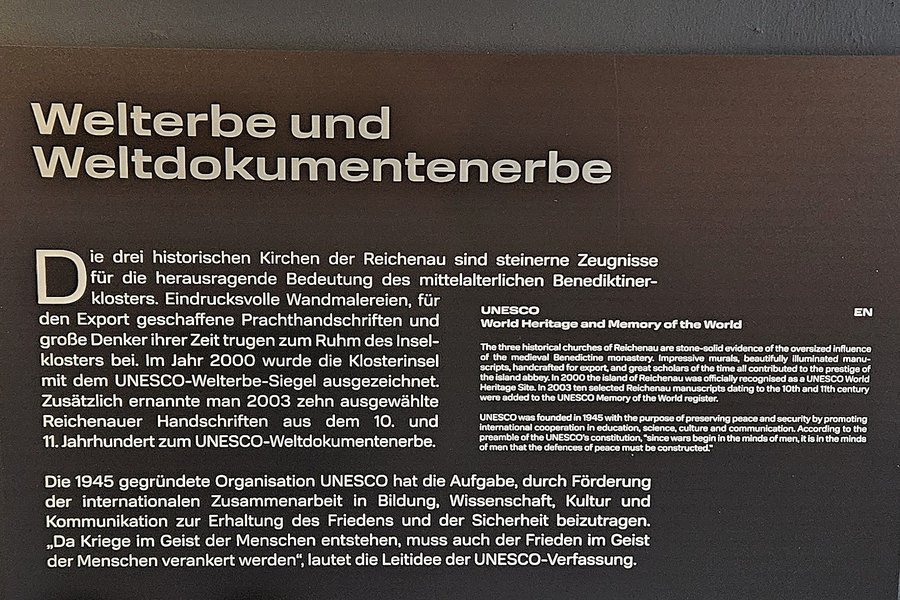
I was on Reichenau last week and it appeared that elements of the special exhibition in Konstanz (mentioned by Caspar) have now been given a place in the new building next to the main museum on Reichenau in Mittelteil. I found this a very informative multimedia experience. Of course, it doesn't change that the original paintings, manuscripts, etc. are kept in various other places, but that is about the first thing that you read when entering the museum. Still, judging previous reviews, this modernisation of the museum seems a good step forward in demonstrating the history and importance of the island. So do go there, before visiting the churches.
Or, as they say themselves: "Zum Jubiläum wurde auch das Museum Reichenau unter Mitwirkung des Badischen Landesmuseums neu konzipiert – mit dem Ziel, neueste Forschungsergebnisse und fundierte Fakten ebenso verständlich wie anschaulich zu vermitteln. Die durch archäologische Grabungen oder neue Ansätze in der Handschriftenkunde gewonnenen Erkenntnisse flossen in das Ausstellungskonzept mit ein. Eine innovative mediale Vermittlung schafft nun ein Besuchserlebnis für ein breites Publikum am historischen Originalschauplatz. Diese neue Dauerausstellung auf der Insel Reichenau bleibt natürlich auch nach Ende der Großen Landesausstellung bestehen. Zudem werden zwei interaktive Medienstationen, die für die Ausstellung in Konstanz entwickelt wurden, in das Museum Reichenau gebracht und dort nachhaltig weitergenutzt."
Keep reading 0 comments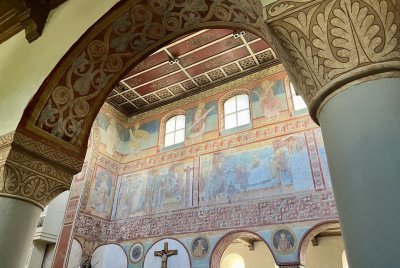
This site is rather hard to grasp: The undoubtedly enormous religious, political and artistic importance of this monastery is comprehensible only in traces by the three churches left on the island of Reichenau. I start in the west (with the least interesting IMHO): St. Peter and Paul is heavily baroquified and only the apsis behind the altar shows interesting frescoes. They are bit far and dark and therefore difficult to see and appreciate. The main church, the Basilica Minor St. Maria und Markus, is an impressive structure but it has little charm: While the quire is heavily baroquified the nave is rather empty (probably since the reformation): But the church has a remarkable treasury with several ancient (pre-baroque!) treasures: a must. The jewel of the island is clearly the church of St. George with is Ottonian frescoes from around 1000AD. They have nothing to be compared with north of the alps and are well worth the trip from anywhere. They can only be visited by tours which are offered quite regularly, at least in summertime. Like many frescoes they are quite well preserved because they were painted over during the reformation. The presentation of the churches has been improved in recent years and now there is a little museum next to each of the churches to give more background.
Core zone: It contains the complete island what makes in a way sense since, at the time, the whole island was part of the monastery and much of its land …
Keep reading 0 comments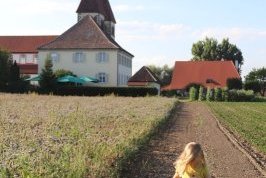
July 2022 - second day of our Roadtrip this was our evening goal. We were welcomed by the wonderful poplar avenue which marks the southern end of the Deutsche Alleenstraße. We aimed at the only campground on the Island but fortunately left it again. A terrible place. The Islands official swimming beach offered free entrance and free shower.
The night we spent on one of the numerous parking lots, in the morning we still wanted to visit the third of the old churches. Unfortunately none of them was open during our visit, thus we missed on the islands OUV. Everything else was rather boring. Later in our trip we visited Ile. St. honorat at Cannes. Probably a comparable site, which I would rather see on the WHS list.
However, near Konstanz and the whole area is definitely another place worth visiting. Maybe at some point there might be an extension to Cultural Landscape of Lake Constanze.
Keep reading 0 comments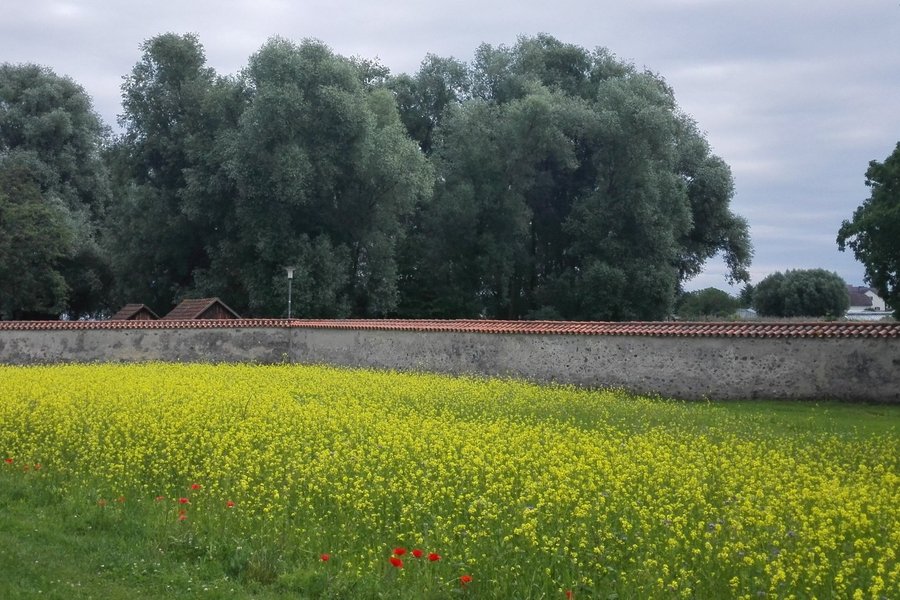
Reichenau is an island on the Bodensee/Lake Constance where the monastic tradition dates to the 800s. The island has three remaining churches that date to the 11th/12th centuries, and some original paintings remain. The island has built small museums by each church with some information— however, it was a lot less history/information/signage than nearby St. Gall
I visited St. Gall and Reichenau in a single day by rental car from Zurich. Both sites are about an hour from Zurich and an hour from rich other. It’s possible to do the same route by train, but the Reichenau train station is a bit far from the island — it’d be about a 3-hour round trip walk from the station to the furthest church on the island, so I felt I’d be rushed to do both in a single day without renting a car. It’s a popular cycling destination, but I didn’t see places to rent bikes on the island.
As others helpfully pointed out, St. George is only open May-September twice a day by guided tour to protect the paintings. The tour times are still 12:30 and 16:00 daily. I confirmed the times with the visitors center before my trip. Unfortunately, no one shows up for the 16:00 tour the day I visited. No sign on the door/note it was cancelled. A group of 12 of us waited, myself for 30 minutes, before giving up. That was disappointing to say the least. Hopefully others will have better luck. (Note …
Keep reading 0 comments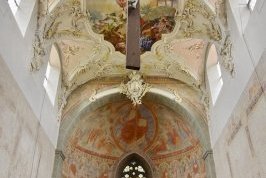
Despite my friend’s week long architectural tour was mainly focus on Southern Bavaria, certain addition, as demanded by a fussy World Heritage enthusiast, were located in Baden Württemberg, the three UNESCO listed churches on Reichenau Island. To reach the island we crossed Lake Constance twice, a ferry from Meerburg to Konstanz and another bridge to Reichenau. The island was lovely with many vegetable gardens and very well maintained bicycle lanes, Reichenau is well known destination for cyclists.
After had fine sandwiches for lunch from the popular shop opposite St. Georg Church, one of the three listed churches on the island, as other reviewers mentioned we also took a tour to see the medieval paintings of the church. The wall paintings were really nice, but I really enjoyed the wooden ceiling with medieval motif and overall Romanesque style of the whole church building. After that we drove to Basilica of Sts. Peter and Paul. Despite its exterior of Romanesque, its interior surprisingly baroque with plain white wall with some cute baroque motif and fresco. The basilica was very well restored and looked really new, only the wall painting behind the altar that gave us a clue that this place was medieval structure. Then we went to the last of three UNESCO churches, Abbey Church of St Mary and Mark, also the biggest one on the island. The complex was a mix of Romanesque and Gothic. Its medieval wall paintings were located in Gothic part in order to …
Keep reading 0 comments
It has taken me 17 years, but in late June 2016 I finally ´finished´ Germany: I have now seen all 40 WHS in this country. The last one left to do was the Monastic Island of Reichenau, some 10km from the border with Switzerland. I visited it on a day trip by car from Zürich Airport. Unfortunately, my camera had broken down two days before when touring the Swiss Alps, so I can only show some images taken with my smartphone.
The Monastic Island of Reichenau originated in the 8th century when the traveling monk Pirmin founded the first monastery on this island in Lake Constance. Some 24 other churches and chapels were added in the remainder of the early Middle Ages, and religious relics were shipped in (often gifts by pilgrims). The large Benedictine monastery developed into an important center for study and arts in the empire of Charlemagne and his successors. The island also is very suitable for agriculture (then and now), so the monks could be self-sufficient.
Nowadays it’s a holiday island with only 3 churches left. Many tourists arrive here by bicycle from Konstanz. The island covers just over 4 square kilometers, so all is easy to reach. There are three villages, and the middle one of these (Mittelzell) has the most amenities. This is also the site of the main museum of the island, and I made that my first stop. The history of the monastery island is told using information panels and …
Keep reading 0 comments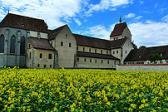
I visited this WHS in July 2014. I spent 1 night and 2 days here and had a great time exploring the island and the nearby Kostanz lake by bicycle. The loop round the island is an easy ride and after visiting the 3 churches and 3 museums, I cycled to the highest point of the monastic island to enjoy the panoramic view. The best church interior and frescoes are indeed the ones of St Georg. For conservation reasons, from May to September 2014, it's only possible to visit at 12:30 and 16:00 with a guided tour in German costing 2 euros.
Keep reading 0 comments
This is a film I made about the monastery island of Reichenau in southern Germany. (Swedish voice-over with English subtitles).
Keep reading 0 comments
I reached Reichenau Island by bus from Reichenau station on the mainland. After crossing the causeway the bus took me to Mittelzell, close to the museum and the church of SS Mary & Mark.
From there I took the island bus to Neiderzell where I visited the church of SS Peter & Paul. Next stop was the ferry dock where I visited the nearby mansion of Konigsegg, before going on to Oberzell and the church of St George.
From Oberzell I returned on foot across the causeway, stopping to see Schopflen, a ruined mansion, and the Kinderbild chapel, with its simplistic artworks on the way.
Keep reading 0 comments
Reichenau is a small island in Lake Constance. It can be reached in a short bus ride from Konstanz. On a sunny day, it is very pleasant to explore the island, which is about 5 by 2 km in size, by bicycle or on foot - as I did. You walk through fields and small villages, and along the scenic lakeshore. The 3 WHS-inscribed churches are located in the northern, central and southern parts of the island. All 3 were inscribed because of their medieval murals and the role the island played in the spread of Christianity in the Middle Ages. The Benedictine convent of Reichenau was closely connected to the one in St. Gall, which is only a short train ride away. The best murals can be seen in St. George, while the other 2 are less impressive. The biggest church is in the centre and has a nice treasury. The inscription on the WH list seems to be justified because of the historic importance of the island, but today there is not that much to see anymore. There is a small and very interesting museum in the main village, but today most people come for hiking and cycling.
Keep reading 0 comments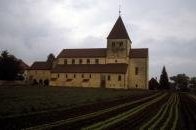
On one of our long drives across Europe to get back to the UK at the end of a holiday we had slept in our car at a Rastplatz near Konstanz and noted the presence nearby of the WHS of Reichenau Island. Thus it was that we briefly visited this Bodensee island at 7am one misty morning. In fact you hardly notice that you have left the “mainland” as you cross a small channel. The island is rolling/low lying and largely consists of fields of market garden produce. It contains several medieval churches. Luckily at that time of the morning we found one of the churches open as a lady cleaned it and replaced the flowers. The murals dating from the 10th century were certainly very fine.
But should it really be a “World Heritage Site”??
The reason for the island’s inscription is that the first German Benedictine monastery was founded there in 724. The whole island was run as a “monastery” and still has 3 churches dating from 8th to 13th century. So it meets a number of criteria concerned with cultural tradition, buildings, land use and artistic work.
No doubt some will say that one cannot rate such a place on the basis of a rushed morning visit and entering a single church. Michelin gives it a single “*” (“Worth a visit”) – and that is about what I would give it. If you are in the area by all means take it in - but if this …
Keep reading 0 comments
